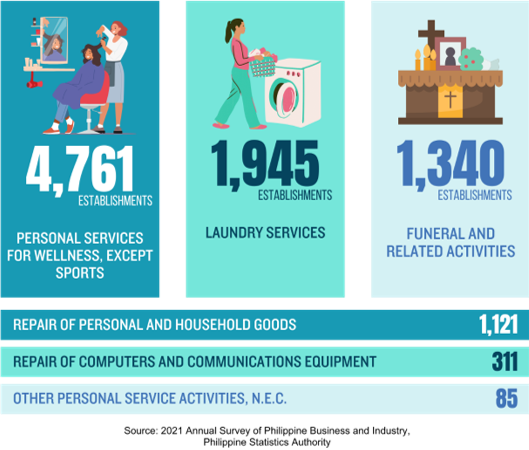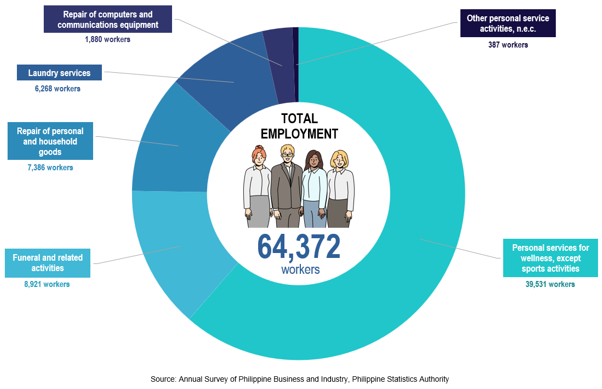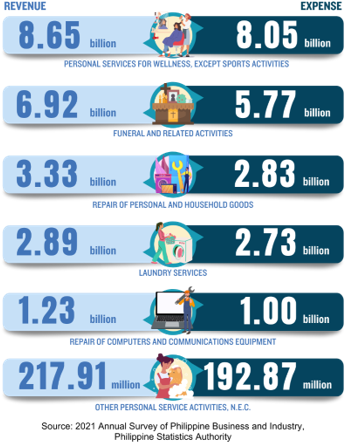The Annual Survey of Philippine Business and Industry (ASPBI), one of the designated statistical activities of the Philippine Statistics Authority (PSA), generates essential statistics for economic planning and analysis. It is specifically designed to collect and generate information on the levels, structure, performance, and trends of economic activities of the formal sector of the country’s economy.
The 2021 ASPBI is the 49th in the series of annual surveys of establishments in the country. It was conducted nationwide in April 2022 with 2021 as reference period. In this round of the ASPBI, the 2021 Survey on Information and Communications Technology (SICT) is a rider to this survey
This Special Release discusses the performance of the Other Service Activities Sector which includes repair of computers and communications equipment; repair of personal and household goods; personal services for wellness, except sports activities; laundry services; funeral and related activities; and other personal service activities, n.e.c.
Establishments engaged in other service activities increase
The results of the 2021 Annual Survey of Philippine Business and Industry (ASPBI) showed that a total of 9,564 establishments in the formal sector were engaged in other services activities. This was 7.3% higher than the 8,910 recorded establishments in 2020. Other service activities include the activities of membership organizations, the repair of computers and personal and household goods and a variety of personal service activities not covered elsewhere.
Among the industries comprising the sector, personal services for wellness, except sports activities, which include activities providing services for wellness such as hairdressing and other beauty treatment, activities of spa, steam bath, sauna, solarium, reducing and slandering saloon, massage saloon and Turkish bath, recorded the highest number of establishments with 4,761 or 49.8% of the sector. This was followed by laundry services with 1,945 establishments (20.3%) and funeral and related activities with 1,340 establishments (14.0%).
Figure 1. Top Other Service Activities by Number of Establishments, Philippines: 2021

Across regions, most of the establishments engaged in other service activities were located in the National Capital Region (NCR) with 3,146 establishments. Further, nearby regions CALABARZON and Central Luzon had 15.3% and 9.2% shares, respectively. On the other hand, MIMAROPA Region and the Bangsamoro Autonomous Region in Muslim Mindanao (BARMM) contributed the least to the total number of sector establishments with a combined 1.1% share.
Three-fourths of sector employment come from personal services for wellness, except sports activities, and funeral and related activities
In 2021, a total of 64,372 workers were employed in the other service activities sector in the Philippines – a 4.0% increase from the 61,913 employees recorded in the previous year. Majority of this workforce were paid employees while the remaining 3.1% were working owners and unpaid workers.
Among industry groups, personal services for wellness, except sports activities generated the most employment with 61.4% of the total national sector employment, equivalent to 39,531 workers. Funeral and related activities followed with 8,921 workers or 13.9% share. These two industries combine for 75.3% of the total other service activities employment in the country. On the other hand, other personal services, n.e.c., which include social activities such as escort services, dating services, services of marriage bureau; pet care services; shoe shiners, porters, valet car parkers, etc.; and genealogical organizations, had the least contribution to the employment generated by the sector in the Philippines with 0.6%.
Figure 2. Percentage Distribution of Employment in the Other Service Activities Sector by Industry Group, Philippines: 2021

By region, NCR had the highest employment with 23,654 workers, more than one-third of the total sector employment in the country. CALABARZON followed with 10,513 workers, Central Visayas with 7,009 workers, Central Luzon with 5,508 workers, and Western Visayas with 3,744 workers. These five regions comprised more than three-fourths of the total employment generated by the other service activities. On the other hand, there were only 779 workers employed in the sector in CAR.
In terms of ratio, the other service activities sector posted an average employment of seven workers per establishment. This was the same with the previous year’s average employment.
Repair of computers and communications equipment, posted the highest average employment with eight workers per establishment among all other service activities industries. Region-wise, NCR and Central Visayas recorded the highest average employment with eight workers per establishment. Moreover, Cagayan Valley, CALABARZON, Western Visayas, and BARMM all had seven workers per other service activities establishment. Other service businesses were composed of five workers, on the average.
Income of other service activities exceed expenses by more than two billion
Establishments engaged in other service activities generated a total revenue of PhP 23.3 billion in 2021, which was 22.1% higher than the recorded total revenue in 2020 of PhP 19.0 billion.
Figure 3. Top Other Service Activities Industries by Annual Revenue and Expense,
Philippines: 2021
(In Philippine Pesos)

More than half of the total sector income was contributed by establishments engaged in personal services for wellness, except sports activities, and funeral and related activities with a combined revenue of PhP 15.57 billion. Further, relfecting the national trend, the income generated by personal services for wellness establishments grew by 14.0% while income of funeral and related activities expanded by 10.5%. The third top-earners were establishments offering services on repair of personal and household goods with PhP 3.33 billion (14.3%). Laundry services followed and accounted for 12.4% (PhP 2.89 billion) of the total revenue of the sector. Meanwhile, establishments related to other personal service activities, n.e.c. contributed less than a percent to the income of other service institutions in the country with PhP 217.91 million.
Across regions, other service establishments situated in NCR generated the most income accounting for almost 40% of the total sector revenue with PhP 9.01 billion. This was followed by neighboring region CALABARZON with a PhP 3.88 billion revenue. On the other hand, the regions with the least contributions to the income of the other service sector include BARMM with PhP 13.92 million, SOCCSKSARGEN with PhP 179.87 million, and Cordillera with PhP 181.44 million. Together, these three regions accounted for 1.6% of the total income of the sector.
In terms of expenditure, personal services for wellness establishments spent PhP 8.05 billion on compensation and other expenses in 2021, a 2.3% increase from the previous year’s costs of PhP 7.86 billion. In addition, the amount spent for the compensation of employees made up only 29.9% of the sector’s total spending, higher than the amount released by institutions for the wages of their workers in 2020.
The industry top income-earners in other service activities were also the main contributors to the sector’s expenses – personal services for wellness establishments spent PhP 8.05 billion (39.1%); funeral and related activities companies released PhP 5.77 billion (28.1%); and repair of personal and household goods institutions expended PhP 2.83 billion (13.7%). Region-wise, businesses located in NCR (PhP 8.41 billion), CALABARZON (PhP 3.36 billion), and Central Visayas (PhP 2.94 billion) were the top spenders in 2021.
Repair of computers and communications equipment generates the highest revenue per expense ratio
By revenue per expense ratio, other service activities posted an acceleration of 4.6% from a 1.08 ratio in 2020 to a 1.13 ratio in 2021. This means that for every peso spent in 2021, other service activities industries earned PhP 1.13 of income.
Repair of computers and communications equipment recorded the highest revenue per expense ratio of 1.23, followed by funeral and related activities with a revenue per expense ratio of 1.20, and repair of personal and household goods with a 1.18 ratio.
All regions recorded income per expense ration that were higher than the national ratio (1.13) except for Ilocos Region, MIMAROPA Region, and SOCCSKSARGEN all with 1.13, and Bicol Region with 1.03. Meanwhile, CAR establishments posted a revenue per expense ratio of 1.14.
Annual wage of paid employees increases by 9% on the average
The annual average earnings of paid employees in the other services sector increased by 9.4% from and an average annual compensation of PhP 90,235 in 2020 to PhP 98,731 in 2021.
Among industry groups, repair of computers and communications equipment recorded the highest average annual compensation per paid employee with PhP 154,147. This was followed by funeral and related activities, and repair of personal and household goods with PhP 141,347 and PhP 112,452, respectively. On the other hand, laundry services posted the lowest average annual compensation per paid worker with PhP 85,171.
Among regions, Central Visayas had the highest average annual compensation per paid employee with PhP 141,170. NCR followed with PhP 107,971 and Western Visayas with PhP 100,484. On the average, employees of other services establishments in CAR were paid PhP 52,180 in 2021.
(SGD)
VILLAFE P. ALIBUYOG
Regional Director
Technical Notes
Establishment is an economic unit under a single ownership and control, i.e. under a single entity, engaged in one or predominantly one kind of economic activity at a single fixed location.
Economic activity is the establishment’s source of income. If the establishment is engaged in several activities, its main economic activity is that which earns the biggest income or revenue.
Total Employment refers to the total number of persons who work in or for the establishment. This includes paid employees, working owners, unpaid workers, and all employees who work full-time or part-time including seasonal workers. Also included are persons on short-term leave such as those on sick, vacation or annual leaves, and on strike.
Paid employees are all persons working in the establishment and receiving pay, as well as those working away from the establishment paid by and under the control of the establishment. Included are all employees on sick leave, paid vacation or holiday. Excluded are consultants, home workers, receiving pure commissions only, and workers on indefinite leave.
Compensation is the sum of salaries and wages, separation/retirement/terminal pay, gratuities and payments made by the employer in behalf of the employees such as contribution to SSS/GSIS, ECC, PhilHealth, Pag-ibig, etc.
Salaries and wages are payments in cash or in kind to all employees, prior to deductions for employee’s contributions to SSS/GSIS, withholding tax, etc. Included are total basic pay, overtime pay and other benefits.
Income or Revenue refers to cash received and receivables for goods/products and by-products sold and services rendered. Valuation is at producer prices (ex-establishment) net of discounts and allowances, including duties and taxes but excluding subsidies.
E-commerce refers to the selling of products or services over electronic systems such as Internet Protocol-based networks and other computer networks. Electronic data Interchange (EDI) network, or other online system. Excluded are orders received from telephone, facsimile and e-mails.
Expense refers to cost incurred by the establishment during the year whether paid or payable. This is treated on a consumed basis. Valuation is a purchaser price including taxes and other charges, net of rebates, returns and allowances. Goods and services received by the establishment from other establishments of the same enterprise are valued as though purchased.
Value added is gross output less intermediate input.
Intermediate input is equal to the sum of the following expense items: materials and supplies purchased; fuels, lubricants, oils and greases purchased; electricity purchased, water purchased; industrial services done by others; non-industrial services done by others less rent expense for land; research and development expense; environmental protection expense; royalty fee; franchise fee; foreign exchange losses and other expense.
Gross addition to tangible fixed assets is equal to capital expenditures less sale of fixed assets, including land.
Change in inventories is equivalent to the value of inventories at the end of the year less the value of inventories at the beginning of the year.
Inventories refer to the stock of goods owned by and under the control of the establishment as of a fixed date, regardless of where the stocks are located. Valuation is at current replacement cost in purchaser prices. Replacement cost is the cost of an item of its present price rather than its original cost.
Subsidies are all special grants in the form of financial assistance or tax exemption or tax privilege given by the government to aid and develop an industry.

